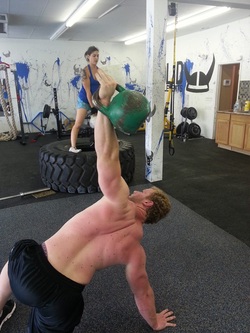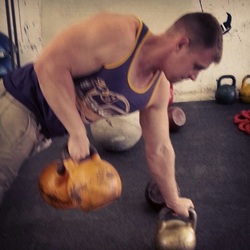Before I get into specifics on repetitions and days performed, I want to give a brief description of how to do a proper swing. Here is a three part description on how I view the swing.
Tension- the first dimension of the swing that I teach my clients is proper muscle tension at the two parts of the swing. The first part is the bottom of the swing. This is when the bell is back between your legs right before your hips power the bell forward. At this point you should be very conscious to have a straight torso, your abs contracted, and your shoulders pulled back for good posture. Having your torso lined up will allow you to "load" the hamstrings. This is an important dimension to the swing as the hamstrings and glutes(the butt muscles) will be responsible for firing the kettlebell forward. You want to feel a slight stretching of the hamstrings at the back of your swing, this is the "load". If you are not, then try to bend more at the hip and allow the bell to go back further without compromising your straight torso. The second aspect of tension is the top of your swing. At the top of the kettlebell swing your body should be completely straight including your knees, hips, and shoulders. With a proper swing the bell will almost float at shoulder height. You should be contracting your glutes and abs which will protect your lower back. Many clients I work with experience lower back pain and fatigue, but by using the right tensions you should mostly feel this in your hamstrings and glutes.
Flow- for anyone that has performed a kettlebell swing you probably understand the endurance that is required to do a high repetition swing workout. The swing is a continuous movement that can be chained together for high repetition sets, but you must have a good flow to complete this. The flow refers to the continuous movement of the bell and the connection of each repetition. You should be able to complete many repetitions without much variance in the repetitions. Some people can pick this up very quickly, but others struggle with the flow of the movement. The main problem that these people have is that they try to control the bell with their arms on the way up and down on the swing. This causes the back and shoulders to work too hard and fatigue quickly. To these people I usually utter the phrases, "Let your hips determine how high the bell goes" meaning don't lift with the shoulders, and "Let it drop" meaning don't control the bell on the way down with your arms. The bell should be free moving and its trajectory is determined on your explosiveness and your ability to relax between the two points of tension.
Pop- one of the most beneficial points of kettlebell training is the development of hip explosiveness. A proper swing will be driven by the explosive extension of the hips, not the arms or back. The pop of the hips is what sends the bell into the air and starts your swing. You want to fire the hips forward once the bell has reached the bottom of the swing and your hamstrings have been loaded. Firing the hips too early will fatigue the back and shoulders. You know you are popping the bell correctly if it floats at the top of your swing. This is an important aspect in the swing. The bell should float, which requires a very straight body. If you are leaning back at the top of the swing then the bell will not float and will fatigue your back. It will be easier to master this portion of the swing when you have a good understanding of the previous two.
Well that "brief" description wasn't so brief- pretty typical of me- but I hope you have a better understanding of this powerful movement. The swing challenge is very simple, but not easy: Do 10,000 swings in one month. To complete this challenge you must set up a good plan to attack this number daily or every other day. Anything less than 3 days a week of swings will force you to spend over an hour swinging. I have laid out a few plans for people who don't have kettlebells at home and can only use them at their gym 3 or 4 times per week. Try to mix it up each workout instead of just doing the same sets, reps, and weight each day. You will see more of a benefit if can mix in high repetition/low weight and low repetition/high weight workouts to get to your final number.
Warning: performing this challenge will cause the following side effects:
- fat loss
- stronger hips
- better cardiovascular endurance
- more shapely butt and hamstrings
- improved jumping
- stronger grip
- improved swing technique
If you need help putting together a plan then feel free to contact me and I can email you one of the schedules I have made or if you need someone to critique your technique then feel free to set up a session. Good luck!
*Below is a schedule that I am following for my month. I have a couple bells at home so this may not work for some people. Just email me and I will send you the 3, 4, or 5 times a week plan.*



 RSS Feed
RSS Feed
